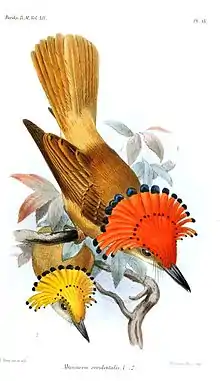Pacific royal flycatcher
The Pacific royal flycatcher (Onychorhynchus occidentalis) is a species of passerine bird in the family Tityridae according to the International Ornithological Committee (IOC). It is found in western Ecuador and northwestern Peru.[2]
| Pacific royal flycatcher | |
|---|---|
 | |
| Male (above) and female (below); illustration by Joseph Smit, 1888 | |
| Scientific classification | |
| Domain: | Eukaryota |
| Kingdom: | Animalia |
| Phylum: | Chordata |
| Clade: | Dinosauria |
| Class: | Aves |
| Order: | Passeriformes |
| Family: | Tityridae |
| Genus: | Onychorhynchus |
| Species: | O. occidentalis |
| Binomial name | |
| Onychorhynchus occidentalis (Sclater, PL, 1860) | |
 | |
| Synonyms | |
|
Muscivora occidentalis | |
Taxonomy and systematics
The IOC considers the Pacific royal flycatcher and three other royal flycatcher taxa to be separate species and places them in the family Tityridae. The South American Classification Committee of the American Ornithological Society (SACC-AOS) and the Clements taxonomy consider the four to be subspecies of the widespread royal flycatcher (Onychorhynchus coronatus sensu lato). SACC-AOS places O. coronatus in family Onychorhynchidae and includes four other flycatcher species in that family. Clements places it in family Oxyruncidae and includes those four, one other flycatcher, and the sharpbill. IOC considers all of them to be in Tityridae.[2][3][4]
Description
The Pacific royal flycatcher is 16.5 cm (6.5 in) long. One female specimen weighed 14.2 g (0.50 oz). The species is bright tawny brown above and yellow-orange below. The rump and tail are buffy cinnamon. The bill is long and broad. It has an erectile fan-shaped crest that is red in the male and yellow in the female.[5]
Distribution and habitat
The Pacific royal flycatcher is found in western Ecuador discontinuously from Esmeraldas Province to El Oro Province and slightly into Peru's Department of Tumbes. It inhabits humid lowlands, both primary evergreen and second growth forests. It is a bird of the midstory, often along streams.[5]
Behavior
Feeding
All of the royal flycatchers are insectivorous.[5]
Breeding
A Pacific royal flycatcher's active nest was found in Ecuador in January. The nest is long and narrow and is suspended from a branch or vine, usually above water. The clutch is two eggs; only the female incubates them and broods and feeds the nestlings.[5]
Vocalization
The Pacific royal flycatcher is usually inconspicuous and quiet. Its song is "a descending, slowing series of plaintive whistles" and its call a repeated "keeeyup or keee-yew" .[5]
Status
The IUCN has assessed the Pacific royal flycatcher as being Vulnerable. "Rapid rates of deforestation have reduced this species's now small and severely fragmented range and population."[1]
References
- BirdLife International (2016). "Onychorhynchus occidentalis". IUCN Red List of Threatened Species. 2016: e.T22699653A93742094. doi:10.2305/IUCN.UK.2016-3.RLTS.T22699653A93742094.en. Retrieved 13 November 2021.
- Gill, F.; Donsker, D.; Rasmussen, P. (January 2021). "IOC World Bird List (v 11.1)". Retrieved January 14, 2021.
- Remsen, J. V., Jr., J. I. Areta, E. Bonaccorso, S. Claramunt, A. Jaramillo, D. F. Lane, J. F. Pacheco, M. B. Robbins, F. G. Stiles, and K. J. Zimmer. Version 19 January 2021. A classification of the bird species of South America. American Ornithological Society. https://www.museum.lsu.edu/~Remsen/SACCBaseline.htm retrieved January 19, 2021
- Clements, J. F., T. S. Schulenberg, M. J. Iliff, S. M. Billerman, T. A. Fredericks, B. L. Sullivan, and C. L. Wood. 2019. The eBird/Clements Checklist of Birds of the World: v2019. Downloaded from https://www.birds.cornell.edu/clementschecklist/download/ Retrieved August 15, 2019
- Sample, R., B. Shackelford, and R. Kannan (2020). Royal Flycatcher (Onychorhynchus coronatus), version 1.0. In Birds of the World (T. S. Schulenberg, Editor). Cornell Lab of Ornithology, Ithaca, NY, USA. https://doi.org/10.2173/bow.royfly1.01 retrieved May 8, 2021
